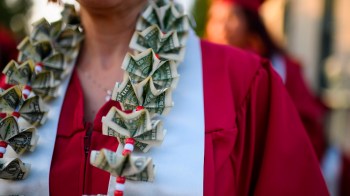Senator Dick Durbin on student loans and student debt
Share Now on:
Senator Dick Durbin on student loans and student debt
Jeremy Hobson: The amount of outstanding student loan debt in this country has reached $1 trillion. And if you scan the headlines this week, you’ll find school after school raising tuition, which will almost certainly send that $1 trillion number up even further.
Democratic Senator Dick Durbin of Illinois is trying to address this issue at the federal level and he joins us now from Washington. Good morning.
Dick Durbin: Good morning.
Hobson: Well, the numbers sound pretty scary. Americans owe now about $1 trillion in student loan debt and people are falling behind on these loans. How serious of a problem is this right now?
Durbin: You know I think this is the next credit bubble, and unfortunately, Congress has virtually ignored it.
Hobson: What are they supposed to do about it?
Durbin: There are several things. First, I think the president was right to call out the institutions of higher learning in his State of the Union address, and tell them that this dramatic increase in the cost of tuition and fees is unsustainable. Secondly, the institutions that are involved in this — many of them, particularly the for-profit schools — are luring kids, and many times their parents, into debt obligations which basically they’ll never be able to repay.
Hobson: When you say it’s the next credit bubble, do you mean that it would have an impact beyond just students who owe this debt — on the broader economy, the way that the mortgage bubble did?
Durbin: I’m not sure it’ll have the same impact, because real estate is such a central part of the economy. But imagine if you will thousands of students across America defaulting on their debts, but being stuck with debts that are not dischargeable in bankruptcy.
Hobson: Who’s at fault here? Is it the lender? Is it the school that’s charging too much — what?
Durbin: I think it’s a variety of things. But basically, the for-profit school industry is driving this train, and unfortunately, it’s not going in the right direction. Ten percent of the students who have graduated from high school are in for-profit schools. Secondly, the for-profit schools receive 25 percent of all the federal aid to education, and almost 50 percent of all student loan defaults come from for-profit schools. So this is a trend line with ought to be frightening, but unfortunately, Congress has really refused to respond.
Hobson: Let’s talk about a non for-profit school in your home state — and my home state, by the way — the University of Illinois, which is raising tuition about 5 percent this year. It’s gone up 25 percent in the last five years. How are people supposed to be able to afford this?
Durbin: That’s a very valid question. It reflects the fact that the state of Illinois is in terrible shape financially, and is not providing assistance to education as it did in the past — particularly higher education. And so these institutions are raising their tuition rates to meet that need. I just think all higher education has spun itself into a level that’s unsustainable. I mean, some of the cost here, of $10, $15, $20,000 of debt each year is just considered normal.
Hobson: Senator Dick Durbin of Illinois, that’s so much for joining us.
Durbin: Good to be with you.
There’s a lot happening in the world. Through it all, Marketplace is here for you.
You rely on Marketplace to break down the world’s events and tell you how it affects you in a fact-based, approachable way. We rely on your financial support to keep making that possible.
Your donation today powers the independent journalism that you rely on. For just $5/month, you can help sustain Marketplace so we can keep reporting on the things that matter to you.


















